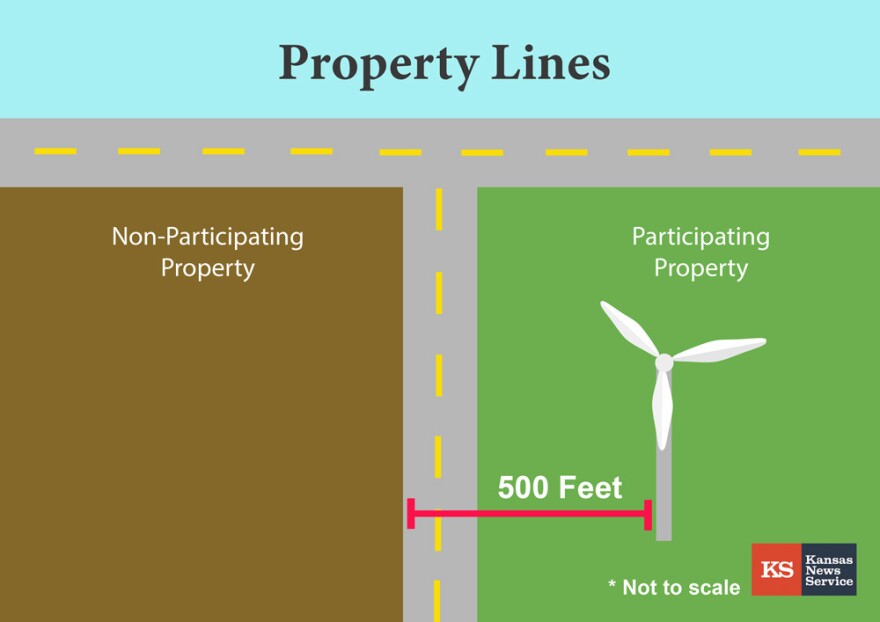Wind farms have been sprouting across Kansas horizons for nearly 20 years, planting ever-more-giant turbines capable of transforming breezes into clean-energy megawatts and remaking the plains-and-prairie landscape.
The rules about how close those towering structures can stand to a road, to a home, or to a property line vary by project and from one county after the next.
Kansas has no statewide rulebook on the setbacks that govern how close a turbine can sit next to, well, anything. At least not yet. Legislators considered a statewide setback bill in 2019, but it didn’t get very far.
Instead, counties have been figuring out regulations as they go. That’s created a hodgepodge of agreements and regulations that range from outright prohibitions to whatever deal wind farm builders can cut with landowners and their neighbors.
Setbacks
One of the most common and hotly contested types of regulations regarding wind farms (see Reno County) has to do with what’s known as a setback. A setback is the distance a wind turbine must be from something else —roads, homes, a neighbor’s land.
Setbacks aim to protect against potential damage from ice that breaks off of the blades and to reduce the impacts of noise and shadows generated by the turbine.
Let’s take a look at how counties have been handling this so far.
No single government agency in Kansas keeps a comprehensive list. What we’re sharing here was gathered through phone calls and emails with county clerks, appraisers and commissioners in counties with operating turbines. Where possible, we’re sharing links to documents with the information. If you have more information to provide, send an email to grimmett@kmuw.org and we’ll update our dataset.
No Setbacks
Clark County
Cloud County
Elk County
Haskell County
Kiowa County
Marshall County
These counties have no setbacks, at least any mandated by the county through an agreement or conditional use permit. They’ve left that to the landowners and the developers.
Largest Setbacks
There are several different types of setbacks, but the most common is how far the turbine must be from houses where people live. That’s also sometimes broken down into whether the house is on land that’s been leased or is on land owned by someone not participating in the project.
Pratt has the largest setbacks in the state.
Setbacks for non-participating houses
- Pratt County - 2,500 feet
- Kingman County - 1,400 feet
- Allen County - 1,400 feet
- Marion County - 1,320 feet
- Barber County, Butler County, Coffey County, Ellis County, Ford County, Harper County, Sumner County - 1,000 feet
Counties have set a more standard number for houses on land participating in the project. In every county that’s set that type of regulation, it’s 1,000 feet — all except Pratt County, which sets it at 2,500 feet.
Typical Setbacks
Every county is free to set its own rules, but some consensus has emerged. While not every county with wind farms has each of these restrictions, it’s generally where most have landed.
Property Lines

500 feet or 1.1 times the height of the turbine at its highest point.
To better understand the math, the average height of a wind turbine in Kansas is 417.7 feet. Multiply that by 1.1 and you get 459.5 feet.
But, new wind turbines do seem to be getting taller. One of the newest projects in the state is in Marion county. It also has the tallest turbines in the state. Each one is 492 feet tall when you include the top of a blade at its peak.
Homes

1,000 feet.
Accessory Structure
The height of the turbine plus 50 feet.
Roads

500 feet or 1.1 times the height of the turbine at its highest point.
Distance of the blade from the ground

This category is more varied. Only six counties even regulate this. It ranges from 40 feet to 100 feet.
It’s also worth noting that wind developers will sometimes exceed the limits set by counties and choose to keep their turbines further away from homes and roads. They generally tend to follow the turbine manufacturer’s recommended setbacks.
Ultimately, finding the right setbacks for each location involves compromise. Developers need space to be able to build enough turbines to make a project economically viable, and the people who live nearby want to be protected from potential hazards and annoyances.
But in Kansas, that ad hoc approach has mostly worked.
While speaking to numerous county officials for this story, most seemed pretty pleased with the arrangements they’d worked out. Generally, there were very few, if any, complaints about the turbines.
Brian Grimmett reports on the environment and energy for KMUW in Wichita and the Kansas News Service, a collaboration of KMUW, Kansas Public Radio, KCUR and High Plains Public Radio covering health, education and politics. Follow him on Twitter @briangrimmett or email grimmett (at) kmuw (dot) org.
Coverage of energy and the environment is made possible in part by ITC Great Plains and the Corporation for Public Broadcasting.
Kansas News Service stories and photos may be republished at no cost with proper attribution and a link ksnewsservice.org.





